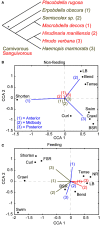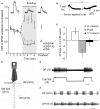Decision points: the factors influencing the decision to feed in the medicinal leech
- PMID: 22783162
- PMCID: PMC3390556
- DOI: 10.3389/fnins.2012.00101
Decision points: the factors influencing the decision to feed in the medicinal leech
Abstract
The decision to feed is a complex task that requires making several small independent choices. Am I hungry? Where do I look for food? Is there something better I'd rather be doing? When should I stop? With all of these questions, it is no wonder that decisions about feeding depend on several sensory modalities and that the influences of these sensory systems would be evident throughout the nervous system. The leech is uniquely well suited for studying these complicated questions due to its relatively simple nervous system, its exceptionally well-characterized behaviors and neural circuits, and the ease with which one can employ semi-intact preparations to study the link between physiology and decision-making. We will begin this review by discussing the cellular substrates that govern the decision to initiate and to terminate a bout of feeding. We will then discuss how feeding temporarily blocks competing behaviors from being expressed while the animal continues to feed. Then we will review what is currently known about how feeding affects long-term behavioral choices of the leech. Finally, we conclude with a short discussion of the advantages of the leech's decision-making circuit's design and how this design might be applicable to all decision circuits.
Keywords: behavioral choice; decision-making; distributed; feeding; leech; modular; sensory gating; serotonin.
Figures




Similar articles
-
A classic model animal in the 21st century: recent lessons from the leech nervous system.J Exp Biol. 2015 Nov;218(Pt 21):3353-9. doi: 10.1242/jeb.113860. J Exp Biol. 2015. PMID: 26538172 Review.
-
Decision-making in the leech nervous system.Integr Comp Biol. 2002 Aug;42(4):716-24. doi: 10.1093/icb/42.4.716. Integr Comp Biol. 2002. PMID: 21708768
-
Evidence for sequential decision making in the medicinal leech.J Neurosci. 2002 Dec 15;22(24):11045-54. doi: 10.1523/JNEUROSCI.22-24-11045.2002. J Neurosci. 2002. PMID: 12486200 Free PMC article.
-
An increase in activity of serotonergic Retzius neurones may not be necessary for the consummatory phase of feeding in the leech Hirudo medicinalis.J Exp Biol. 1996 Jun;199(Pt 6):1405-14. doi: 10.1242/jeb.199.6.1405. J Exp Biol. 1996. PMID: 8691114
-
Multifunctional interneurons in behavioral circuits of the medicinal leech.Experientia. 1988 May 15;44(5):383-9. doi: 10.1007/BF01940531. Experientia. 1988. PMID: 3286283 Review.
Cited by
-
The Role of the Gustatory System in the Coordination of Feeding.eNeuro. 2017 Nov 20;4(6):ENEURO.0324-17.2017. doi: 10.1523/ENEURO.0324-17.2017. eCollection 2017 Nov-Dec. eNeuro. 2017. PMID: 29159281 Free PMC article. Review.
-
Decoding a neural circuit controlling global animal state in C. elegans.Elife. 2015 Mar 11;4:e04241. doi: 10.7554/eLife.04241. Elife. 2015. PMID: 25760081 Free PMC article.
-
Invertebrate behavior-actions or responses?Front Neurosci. 2013 Nov 19;7:221. doi: 10.3389/fnins.2013.00221. eCollection 2013. Front Neurosci. 2013. PMID: 24311998 Free PMC article. No abstract available.
-
Serotonergic modulation of swallowing in a complete fly vagus nerve connectome.Curr Biol. 2024 Oct 7;34(19):4495-4512.e6. doi: 10.1016/j.cub.2024.08.025. Epub 2024 Sep 12. Curr Biol. 2024. PMID: 39270641 Free PMC article.
-
Habituation, sensitization, and Pavlovian conditioning.Front Integr Neurosci. 2014 Feb 11;8:13. doi: 10.3389/fnint.2014.00013. eCollection 2014. Front Integr Neurosci. 2014. PMID: 24574983 Free PMC article.
References
-
- Braak Ter C. J. F. (1986). Canonical correspondence analysis: a new eigenvector technique for multivariate direct gradient analysis. Ecology 67, 1167–117910.2307/1938672 - DOI
Grants and funding
LinkOut - more resources
Full Text Sources
Other Literature Sources

